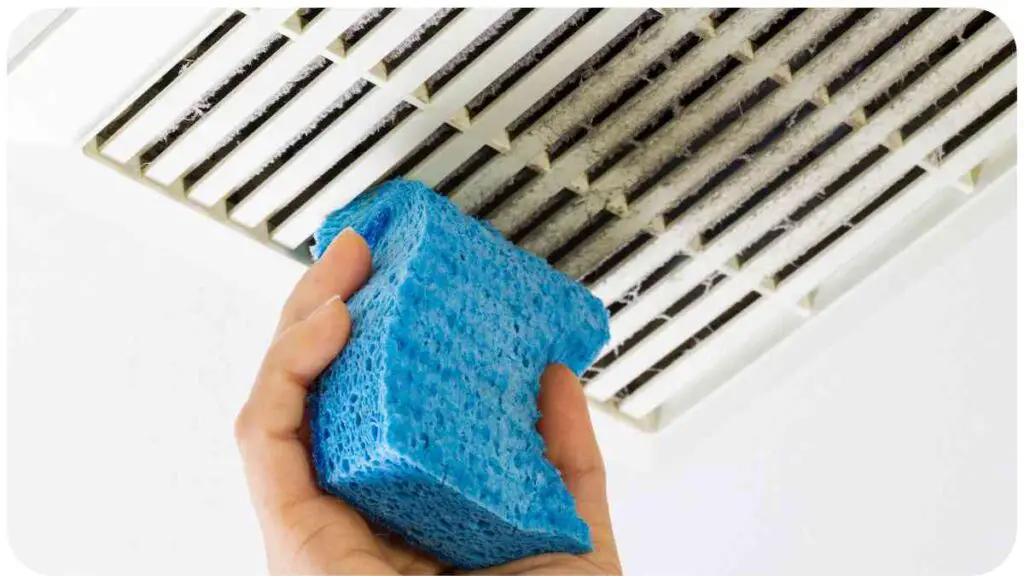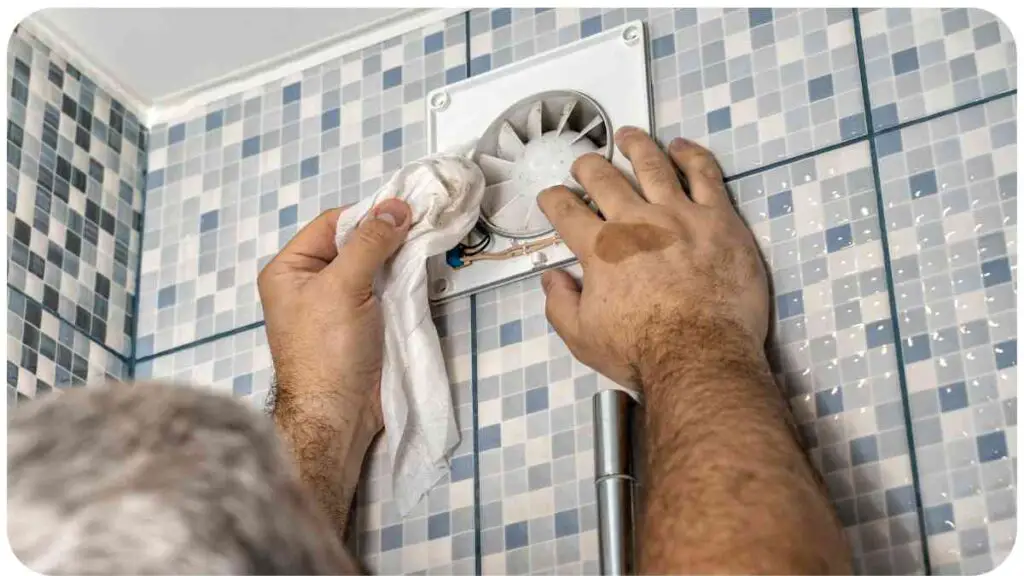We’ve all been there – you turn on your bathroom fan, expecting a gentle hum, but instead, you’re met with an irritating racket. The noise from a bathroom fan can be more than just a nuisance; it might be a sign of underlying issues.
In this guide, we’ll delve into the reasons behind your bathroom fan’s noise and provide practical troubleshooting tips to bring back peace to your restroom sanctuary.
| Takeaways |
|---|
| 1. Regular cleaning is essential for preventing dust accumulation and maintaining a quiet bathroom fan (Table 1). |
| 2. Understanding the Sones rating is crucial when selecting a bathroom fan, with lower ratings indicating quieter operation (Table 3). |
| 3. DIY troubleshooting, including cleaning, lubricating, and tightening, can resolve common fan noise issues (Sections 4 and 5). |
| 4. Consulting a licensed electrician is recommended for complex issues or component replacements (Section 5.1). |
| 5. Upgrading to a quieter model with advanced noise reduction features can enhance your overall bathroom experience (Section 5.3). |
| 6. Consider the size of your bathroom when choosing a fan, matching it with the recommended fan size for optimal ventilation (Table 4). |
| 7. Seasonal maintenance tasks, as outlined in Table 5, help ensure your bathroom fan stays in optimal condition throughout the year. |
| 8. Energy-efficient fans not only save energy but are designed to operate more quietly, contributing to a peaceful bathroom environment (Section 8.2). |
| 9. Real-life success stories highlight the effectiveness of the troubleshooting tips and the positive impact of upgrading to a quieter model (Section 9). |
| 10. Additional resources provide more in-depth information and reviews on quiet bathroom fans for informed decision-making (Section 11). |
Understanding the Importance of Bathroom Fans

Before we jump into the troubleshooting process, let’s briefly explore why bathroom fans are crucial. A well-functioning fan plays a pivotal role in maintaining proper ventilation, preventing mold and mildew growth, and ensuring a comfortable environment.
Tired of chilly showers? Explore troubleshooting tips to ensure a consistently warm bathing experience, resolving the mystery of inconsistent water temperatures.
Common Reasons for Bathroom Fan Noise
3.1 Dust and Debris Accumulation
One of the primary culprits behind a noisy bathroom fan is the accumulation of dust and debris on the blades. Over time, these particles can disrupt the smooth rotation of the fan, resulting in unpleasant sounds.
Table 1: Cleaning Schedule
| Frequency | Cleaning Tasks |
|---|---|
| Monthly | Wipe fan blades with a damp cloth |
| Bi-Annual | Vacuum and clean fan housing |
| Yearly | Lubricate fan motor if applicable |
3.2 Imbalanced Fan Blades
Imbalanced fan blades can cause vibrations, leading to a noisy operation. Regular maintenance and balancing can significantly reduce this common issue.
3.3 Age and Wear
Just like any other appliance, bathroom fans undergo wear and tear over time. Aging components may produce squeaks or rattles, signaling the need for replacement.
3.4 Improper Installation
Sometimes, the source of the noise is traced back to faulty installation. Incorrectly mounted fans or loose screws can create unwanted sounds during operation.
Enhance your shower experience with a simple fix to boost water pressure. Discover easy solutions for a more satisfying and invigorating shower.
DIY Troubleshooting Techniques
4.1 Cleaning the Fan Blades
Regular cleaning is key to preventing dust buildup. Refer to Table 1 for a cleaning schedule that ensures your fan stays in top-notch condition.
4.2 Checking for Loose Parts
Loose parts, such as mounting screws or fan housing, can amplify noise. Conduct a thorough check and tighten any loose components.
4.3 Lubricating the Fan Motor
Applying the right lubricant to the fan motor can significantly reduce friction and noise. Refer to Table 2 for recommended lubricants.
Table 2: Recommended Lubricants
| Lubricant Type | Ideal Application |
|---|---|
| Silicone-based | Fan motor bearings |
| White lithium | Metal parts, shafts, and gears |
| Teflon-based | Quieter operation, long-lasting |
4.4 Tightening Mounting Screws
Ensure all mounting screws are securely tightened. Vibrations from loose screws can amplify noise levels.
When to Seek Professional Help
5.1 Consulting a Licensed Electrician
If DIY troubleshooting doesn’t resolve the issue, it might be time to consult a licensed electrician. They can inspect the fan’s electrical components and identify any potential wiring issues contributing to the noise.
5.2 Replacing Worn-out Components
Components like the fan motor or blades may wear out over time. Professional replacement ensures the longevity and optimal performance of your bathroom fan.
Prevent water damage by learning how to fix your shower’s drywall. Shield your bathroom from potential harm and maintain a dry, pristine environment.
5.3 Upgrading to a Quieter Model
In some cases, an upgrade might be the best solution. Newer models often come with advanced noise reduction features and improved efficiency, offering a more enjoyable bathroom experience.
Choosing the Right Bathroom Fan

6.1 Sones Rating Explained
Understanding the Sones rating is crucial when selecting a bathroom fan. Refer to Table 3 for a breakdown of the Sones rating scale.
Table 3: Sones Rating Scale
| Sones Rating | Noise Level | Example |
|---|---|---|
| 0.5 | Whisper-quiet | Rustling leaves |
| 1.0 | Quiet | Refrigerator hum |
| 2.0 | Moderate | Normal conversation |
| 4.0 | Loud | Busy street traffic |
| 8.0 | Very loud | Heavy machinery |
6.2 Selecting the Appropriate Size
Choosing the right fan size for your bathroom is crucial for effective ventilation. Refer to Table 4 for guidance on matching the fan size with your bathroom dimensions.
Table 4: Bathroom Size vs. Fan Size
| Bathroom Size | Recommended Fan Size |
|---|---|
| Small (up to 50 sq. ft.) | 50 CFM |
| Medium (50-100 sq. ft.) | 100 CFM |
| Large (100-200 sq. ft.) | 150 CFM |
| Extra Large (200+ sq. ft.) | 200+ CFM |
6.3 Features for Noise Reduction
When shopping for a bathroom fan, look for features specifically designed for noise reduction, such as aerodynamic fan blades, insulated housing, and variable speed settings.
Unravel the mystery behind the absence of cold water in your shower. Implement effective solutions to restore a balanced and comfortable showering experience.
Maintaining a Quiet Bathroom Fan
7.1 Regular Cleaning Routine
To keep your bathroom fan operating quietly, establish a regular cleaning routine. This includes wiping the blades, vacuuming the housing, and lubricating the motor if necessary.
7.2 Seasonal Maintenance Checklist
Refer to Table 5 for a comprehensive checklist of seasonal maintenance tasks to ensure your bathroom fan stays in optimal condition throughout the year.
Table 5: Seasonal Maintenance Tasks
| Season | Maintenance Tasks |
|---|---|
| Spring | Clean blades and housing |
| Summer | Check for loose parts |
| Fall | Lubricate fan motor if needed |
| Winter | Inspect and tighten mounting screws |
Benefits of a Quiet Bathroom Fan
8.1 Improved Indoor Air Quality
A well-functioning and quiet bathroom fan effectively removes excess moisture, preventing mold and mildew growth, and promoting better indoor air quality.
8.2 Energy Efficiency
Modern, energy-efficient fans not only reduce noise but also contribute to lower energy bills by operating more efficiently.
8.3 Enhanced Bathroom Experience
A quiet bathroom fan creates a more enjoyable and relaxing environment, enhancing your overall bathroom experience.
Real-life Success Stories
9.1 Jane’s Battle with a Noisy Fan
Jane, a homeowner troubled by a persistently noisy bathroom fan, decided to tackle the issue head-on. Following the DIY troubleshooting tips outlined in this guide, she discovered a layer of dust and debris on her fan blades. Jane diligently adhered to the cleaning schedule in Table 1, and the results were astonishing. Her bathroom fan now operates quietly, providing the ventilation she needs without the annoying noise.
Encountering a clogged shower drain? Follow this step-by-step guide to efficiently clear blockages and ensure smooth drainage for an uninterrupted showering routine.
9.2 Mike’s Upgrade to a Whisper-Quiet Model
Mike, facing constant disturbances from his outdated bathroom fan, opted for an upgrade. Consulting the information in Section 6 on choosing the right bathroom fan, Mike selected a model with a low Sones rating and advanced noise reduction features. The outcome? A whisper-quiet fan that not only efficiently ventilates his bathroom but also adds to the tranquility of his personal space.
Conclusion
In the quest for a quiet bathroom fan, understanding the root causes of noise and implementing effective troubleshooting techniques is key. From DIY maintenance to consulting professionals and choosing the right fan for your space, this guide has provided a comprehensive roadmap to a quieter and more enjoyable bathroom experience.
By incorporating the recommended cleaning schedules, lubrication practices, and selecting an appropriate fan based on size and features, you can transform your noisy bathroom fan into a silent ally in maintaining a comfortable and well-ventilated home.
Remember, a quiet bathroom fan is not just about noise reduction; it’s about creating a serene atmosphere where you can unwind and refresh. Implement the tips shared in this guide, and say goodbye to the annoyance of a noisy bathroom fan.
FAQs
Q1: How often should I clean my bathroom fan?
Refer to Table 1 for a comprehensive cleaning schedule. Monthly wiping and bi-annual vacuuming are essential to prevent dust accumulation.
Q2: What is the ideal Sones rating for a quiet bathroom fan?
The ideal Sones rating depends on your tolerance for noise. Refer to Table 3 to understand different noise levels associated with varying Sones ratings.
Q3: Can I replace my bathroom fan myself?
While some troubleshooting can be done DIY, for complex issues or component replacements, it’s advisable to consult a licensed electrician.
Q4: Are energy-efficient fans quieter?
Yes, modern energy-efficient fans are designed not only to save energy but also to operate quietly. Refer to Section 8 for more details.
Feel free to explore the additional resources for more in-depth information on quiet bathroom fans and make informed decisions tailored to your needs.
Further Reading
Manrose: How to Fix a Noisy Extractor Fan
Manrose provides a comprehensive guide on troubleshooting and fixing a noisy extractor fan. Explore step-by-step instructions and tips to ensure your bathroom fan operates silently.
Early Bird Electricians: Fixing a Noisy Bathroom Fan
Early Bird Electricians offer practical insights into fixing noisy bathroom fans. Learn from their expertise to address common issues and enjoy a quieter bathroom environment.
Melcar Electric: Why Is My Bathroom Exhaust Fan Making a Weird Noise?
Melcar Electric explores the peculiar noises emitted by bathroom exhaust fans and provides insights into identifying and resolving these issues. Discover the reasons behind weird sounds and how to silence them.
FAQs
Q: How often should I clean my bathroom fan?
A: Refer to Table 1 in the guide for a detailed cleaning schedule. Monthly wiping and bi-annual vacuuming are essential for preventing dust accumulation.
Q: What is the ideal Sones rating for a quiet bathroom fan?
A: The ideal Sones rating depends on your tolerance for noise. Consult Table 3 in the guide to understand different noise levels associated with varying Sones ratings.
Q: Can I replace my bathroom fan myself?
A: While some troubleshooting can be done DIY, for complex issues or component replacements, it’s advisable to consult a licensed electrician.
Q: Are energy-efficient fans quieter?
A: Yes, modern energy-efficient fans are designed not only to save energy but also to operate quietly. Refer to Section 8 in the guide for more details.

Hellen James is the author of the blog and a licensed plumber with over 15 years of experience. She shares her knowledge and experience in plumbing and drainage through insightful and informative articles

